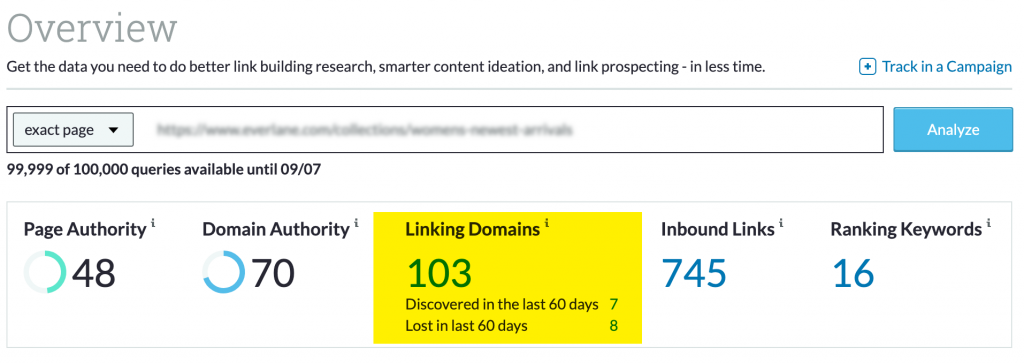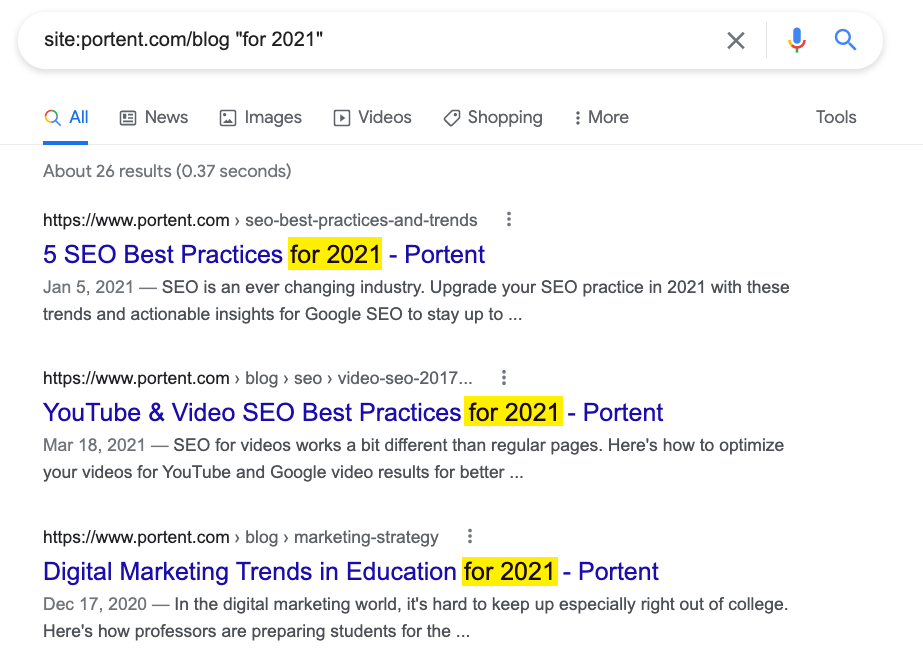As the holiday season approaches, online campaign planning is in full swing. And while a lot of time goes into paid campaign planning, we can’t forget about the user journey that happens after a lead comes in through a paid source.
In this post, organic team lead Kat Shereko and I will share our insights on what tactics B2B and B2C businesses should be taking to optimize their on-page experience and improve conversion rates.
Before the Holidays: 6 Ways To Prep Your Content
If you start to see Halloween decorations emerging in your local grocery stores, you’re already behind the ball on your prep for this year’s holiday season. According to the National Retail Federation, 40% of people start holiday shopping before Halloween – which means your holiday prep work should be done well before that.
A lot goes into content prep for the holidays, and above all else that work can be very time-consuming. However, with a little bit of strategy and a lot of prep work, you can have your content ready for the next holiday season in no time!
1. Audit & Refresh Evergreen Content
Like clockwork, at the end of each year you should be auditing your evergreen content – think guides, resources, blog posts, anything that would likely be deemed as out of date in the new year.
If you organize your content in an editorial calendar, you can start by revisiting all of the content published or updated in the last year. If, however, your content inventory isn’t up to date, you can do a quick search of your website using the site:domain.com operator and identify content that may be out of date mentions of the year in the title or the paget.
At Portent, we’d be looking to update our long-form guides and best practices published on our blog. To do this, we’d do the following search:
site:portent.com/blog “for 2021.”
And if you have a lot of content, we recommend completing a sitewide search using a website crawler like Screaming Frog, or equivalent, so that you can swiftly filter through the noise (e.g., exclude publishing date, include all in-text mentions, etc.).
2. Update Title Tags & Meta Descriptions
Updating your evergreen pages like articles, guides, resource pages, etc., is only half the battle. Although frequently rewritten by Google, title tags and meta descriptions require an equal amount of yearly maintenance.
Before the new year hits, you should have all of your current title tags and meta descriptions reviewed and ready to be refreshed. To tackle this project, you can also do a site search or run a sitewide crawl for all metadata and audit from there.
Need a crash course on how to write title tags and meta descriptions for search engines standards? Check out our guides:
- How to Write a Great Title Tag
- How to Write Meta Descriptions
3. Reuse URLs From Last Season’s Campaigns
A New Year doesn’t mean a new URL… at least not when it comes to holiday landing pages. Before creating a brand new landing page, take a look at the archived or unpublished holiday landing pages from the previous year and see if you can repurpose them.
Repurposing an old URL is beneficial because that page might’ve acquired natural backlinks from years past. And if the page is properly updated, you can leverage that accumulated link equity to help your new content perform better in organic search results.
Need help determining the value of an old URL? Plug your URL into Moz Link Explorer to learn how many domains are currently linking to that page:

Pro-tip, don’t include the publish year in your URLs – this way, you can hang on to that link equity without needing to set up redirects.
4. Test Promo Codes & Special Offers
Promo codes and special holiday discounts are no longer a perk; they’re an expectation. Users know to shop around to get the best deal, so you might as well make sure that deal is coming from you.
If you cannot automatically apply the promo code at checkout, you need to spend some time QAing the code through the checkout process. Make it obvious where the code should be added and show the discount rate immediately after the code is entered.
After all, there’s nothing more frustrating than having a discount code that doesn’t work.
5. Update GMB Listings to Include Promos & Seasonal Campaigns
If you have a local product or service offering, don’t forget to take advantage of your Google My Business (GMB) account by including your holiday promotions in your GMB posts. While there’s no guarantee that the GMB profiles for your local stores will rank better because of the added promotion, mentioning your specials within the listing may increase engagement, or better yet, improve foot traffic to your physical stores.
6. Upload Product Inventory to your Google My Business Profile
At this year’s Google I/O conference, Google announced the Shopping Graph, part of an initiative from the platform to bring more information about online products directly into the search results. During the holiday season, it’s vital to consider Google’s push into eCommerce search results. Thanks to several tools and software services, live product inventory can be displayed directly in search results and on your local store’s GMB profile. When users know exactly what’s locally available, they don’t have to wait for it to be shipped by USPS. The local store becomes an invaluable part of their holiday shopping plans.
Check out the Pointy from Google platform to set up your online product catalog through your store’s POS app on Google My Business.
During the Holidays: What Tests Should You Implement?
As the holiday and seasonal traffic to your website increases, it’s a good idea to consider monitoring page performances to optimize conversions across the funnel that ultimately benefit your business model and customer satisfaction. Conversion rate optimization strategists are your heroes in this stage of the process. They should be equipped with the tools necessary to effectively and efficiently discover opportunities to improve the customer journey and experience. Google Optimize is Portent’s instrument of choice when it comes to A/B testing and analysis.
Creating a Testing Strategy
It’s paramount that when approaching a testing strategy, you’ll need lots of ideas for your areas of focus for conversion rate optimization to experiment with. The potential for increased traffic to your pages speeds up the learning process for your A/B tests. As a result, you’ll need to be prepared to make changes to your website based on these learnings and begin new tests more frequently.
If there is a budget for more qualitative data needed for conversion rate optimization during the holiday season, there’s a great opportunity to recruit people for candid feedback via user testing. You can often incentivize participation in these tests with discounts or gift cards. In exchange, you’ll gain valuable insight into more opportunities for A/B testing from the audiences that matter most to your business goals. As a bonus, you’ll improve the customer experience on your website.
A/B Testing and Optimizations
Once you’ve created your list of pages and elements to test, you’re ready to begin sending these pages out to test to a broader audience to experience. You’ll have tests that conclude elements on your website need changes/improvements, and publishing those changes is crucial before beginning the text next in line. Before you can allow these tests to run, there are a couple of things that a good strategist should consider:
Be mindful of the traffic being brought to the site through your various channels of marketing. Consider the kind of voice/tone/appearance they will be familiar with before arriving at the page and elements being tested. For example, is the experience on a paid landing page consistent with the imagery and verbiage used in the campaign they were brought in from?
Experiment with messaging and copy that will ultimately encourage more visitors to take action and convert on your website. Focus on the time or theme of the season/holiday, the value propositions, or urgency.
This can seem overwhelming at first, especially if you’re new to the world that CRO strategists navigate day in and day out. We’ve been there. With repetition, you’ll be able to improve your website and the customer experience in the future. Build your experiment, gather insights and feedback from user testing, and analyze test results to best inform your next optimizations.
After the Holidays: How To Keep the Momentum Going
We hope the focus and hard work that your teams will put into the holiday season are rewarding and fruitful. Beyond one of the busiest times for your website, you and your teams will still need to act on everything learned from optimizations to content strategy. Here are some of our best recommendations on how to keep the momentum.
Focus On Customer Retention
Successful strategies and results can strengthen remarketing campaigns, such as retargeting for paid advertising, newsletters, and other email marketing promotions.
One way to uncover some of your best strategies and set reasonable expectations for the impending season is to set up forecasting reports for your KPIs. Take these past seasonal performances and compare them year over year to better understand what to expect and prepare for the coming holidays this year and years to come. This way, you can show up along with or before your competitors.
Landing Page Optimization
Pay close attention to results and insights from A/B tests and experiments you run. Analyses from other tools like user testing, heatmaps, and recordings can provide insights into optimizing your page for future campaigns. These learnings will also help develop a roadmap of changes you can make to your landing pages after one of the busiest seasons of your website.
What To Avoid During the Holiday Season
Sometimes we are so caught up in what we have to do to prepare for testing and optimization during a holiday season; we need reminders about what we shouldn’t do. Our teams stay as organized as possible during some of the most critical seasons so we can test and optimize efficiently and effectively. Here are just a few best practices we keep in mind for this special time of year.
Avoid Website Redesigns, Overhauls, or Migrations
One of the last things your website would want to do with a seasonal rush of visitors is to make wholesale changes to the experience. Retailers plan and execute their floor sets in advance of a holiday season, so make sure that if you are making your biggest changes to a website and its pages, it’s in either advance or afterward.
Avoid cross-contaminating A/B Test Audiences
Put simply, avoid running tests where a single-use session will experience two tests at once. Depending on how long of a season you’ll have to test, you may be interested in running tests simultaneously. Our best recommendation is to avoid doing this, but we recognize the advantages of collecting as much insight as possible to make optimizations sooner. Multiple experiments within the same website should also be executed such that messaging or appearance will not contradict the experience on other pages in a customer journey.
Avoid Rearranging Highly Used Features
Do your best to avoid publishing changes to the way visitors will navigate your website. Whether it’s through navigation menus, product hierarchy, categories, or FAQs, your current and potential customers need to retain some familiarity with your website and keep from getting lost on their journey.
In Conclusion
As the holiday season approaches us, yet again, we hope this guide has helped you in preparing your teams for how to start and conduct your Content and CRO plans. Before the season kicks off, nail down your content strategy with thorough prep work. While you’re in the holiday season, leverage CRO to test and implement the small, impactful changes to your page that increase your conversions. Last but not least, take the time after this season to focus on remarketing and making larger changes to your pages based on the learnings you’ll earn along the way.
Have a wonderful holiday from all of us at Portent!
The post Content Strategy & CRO Tips To Prep Your Content for the Holiday Season appeared first on Portent.



